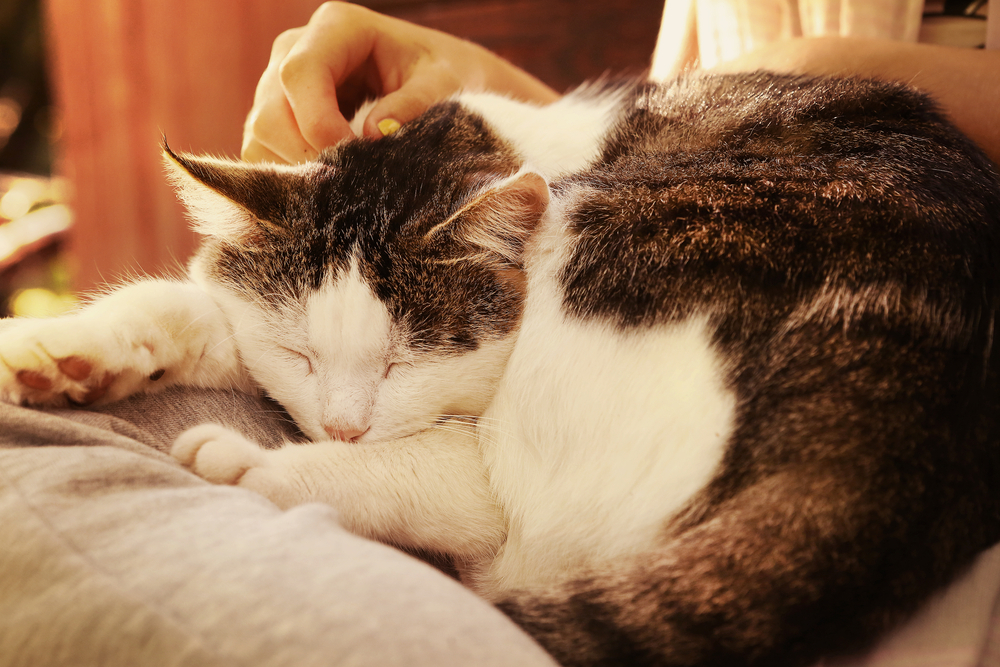Cats are creatures of habit, so transitioning them to a new home and family requires time, empathy, and thoughtful planning. To help ensure a transition that is as smooth and stress-free as possible, the Certified Cat Friendly North Waterloo Veterinary Hospital team compiled a top 10 list of our favorite cat-acclimation tips.
#1: Be patient with your new and current cats
Although you’ll be eager to start sharing your home and life with your new cat, you must recognize that a successful acclimation period can take weeks or longer. The time you invest during this stage can have long-lasting effects on your cat’s emotional health, including their ability to cope with stress and their relationships with other pets.
#2: Isolate your new cat from other pets
Cats who are acclimating to a new home need a quiet, private space where they feel safe. Ideally, they need a room with a door so they have a solid barrier between themselves and your current pets.
Before bringing your new cat home, decide on their room and provide necessary resources, including food and water dishes, interactive toys, litter box, scratching post, hiding places, and a cozy bed.
#3: Cat-proof the room
Inspect the room and remove any potential safety hazards, including:
- Electrical cords
- Breakable or keepsake items
- Toxic plants or flowers
- Long drapes
- Blind cords or string-like decorations
- Choking hazards (e.g., marbles, paper clips, erasers, batteries, candy, gum)
- Candles and essential oils
- Trash
Double-check your work by getting on your hands and knees and examining the room from your cat’s perspective. Finally, secure any potential exits, such as open windows or broken door latches, that could pose a safety hazard and allow an accidental escape.
#4: Leave familiar items in your new cat’s space
When you bring your cat home, take them directly to their new room and set down their carrier. Open the carrier door, but allow your cat to venture out at their own will. Leave the carrier—or box, crate, or other confinement—in the room with any bedding or toys that came from the cat’s previous home or shelter. The smell of these items will comfort your new cat and make their new space feel familiar.
#5: Spend time with your new cat
Although your cat may hide initially, spending time in their space every day is essential to build trust and help your cat feel safe and calm. Some cats will always be ready to play and explore their environment, while others will take days or weeks before they feel comfortable enough to approach you and solicit attention. No matter your cat’s reaction, always proceed at their pace and focus on providing a consistent and calming presence.

#6: Gradually introduce your new cat to other pets
Cats must be introduced slowly to prevent conflict, bullying, and stress. Start by simply allowing the cats to smell each other under the door. Once your new cat is settled—usually a few days after arriving home—place an item that smells like your current cat in the new cat’s space, and vice versa. Once both cats have adapted to the scent, combine the scents by wiping both cats with a towel and allowing each to investigate. If both cats seem unconcerned, allow them to see each other through a crack in the door, then with the new cat confined to a crate, and finally in brief, supervised encounters.
#7: Stop the process if your cat is stressed
The acclimation process can be nerve-wracking for cats, and any rushed step (e.g., meeting other pets) can cause your cat emotional or physical trauma. Ideally, you should anticipate any stress or danger by reading your cat’s body language.
Common feline fear and stress signs include:
- Hiding
- Loss of appetite
- Flattened ears
- Low body posture
- Dilated pupils
- Defensive aggression
- Nervous or fearful behavior
- Over-grooming
- House soiling
If your cat appears anxious or nervous at any point, take one or more steps back in the acclimation process and—once the cat is calm again—resume your introductions in smaller increments.
#8: Gradually remove the barriers between pets
During the acclimation process, always return your new cat to their safe room after they have interacted with other pets or explored a new area of your home. This allows both new and existing pets the opportunity to process the exchange, cool off, and feel safe. You can gradually fade any barriers, such as pet gates or closed doors, until all pets are peacefully coexisting or your new cat has access to the entire home.
#9: Ensure sufficient resources for all cats
Resource availability and access can be a stressor for cats. Ensure all cats have easy access to critical resources (e.g., food, water, litter boxes, toys) throughout your home and on each level. When possible, separate the resources with a visual barrier (e.g., curtain, wall, furniture). Provide one litter box per cat, plus an additional box, to prevent resource guarding or bullying.
#10: Keep a consistent routine for your cat
Predictable routines reduce stress and help cats feel safe. Try to feed, care for, and interact with your cats at the same times each and every day.
Your new cat will provide you with nine lives worth of love. Show them the same kindness with a gentle, thoughtful, and stress-free introduction to their new home and family.
For more feline behavior or training advice and all your new friend’s veterinary care needs, contact the Certified Cat Friendly North Waterloo Veterinary Hospital team, or request an appointment via our online portal.







Leave A Comment